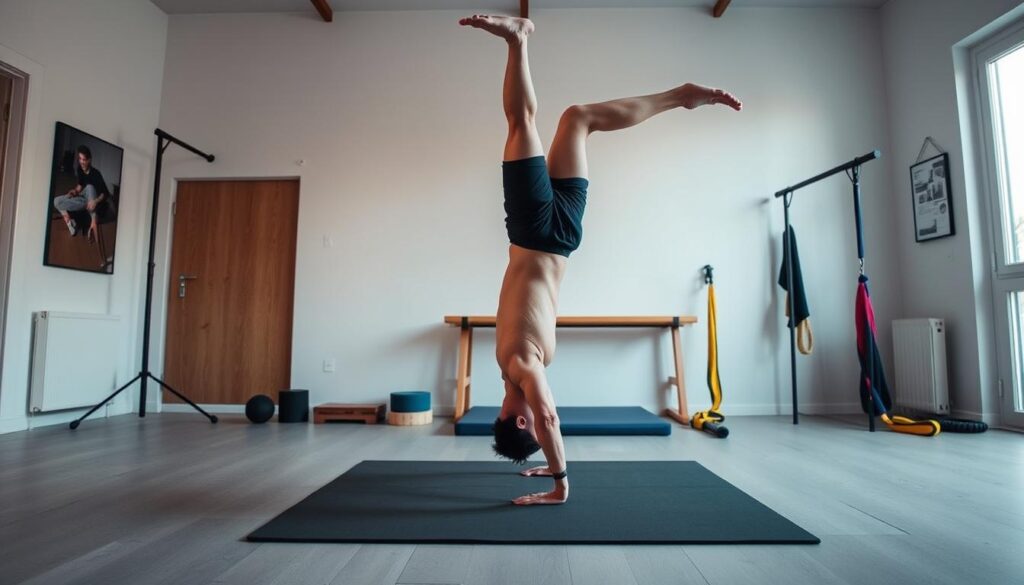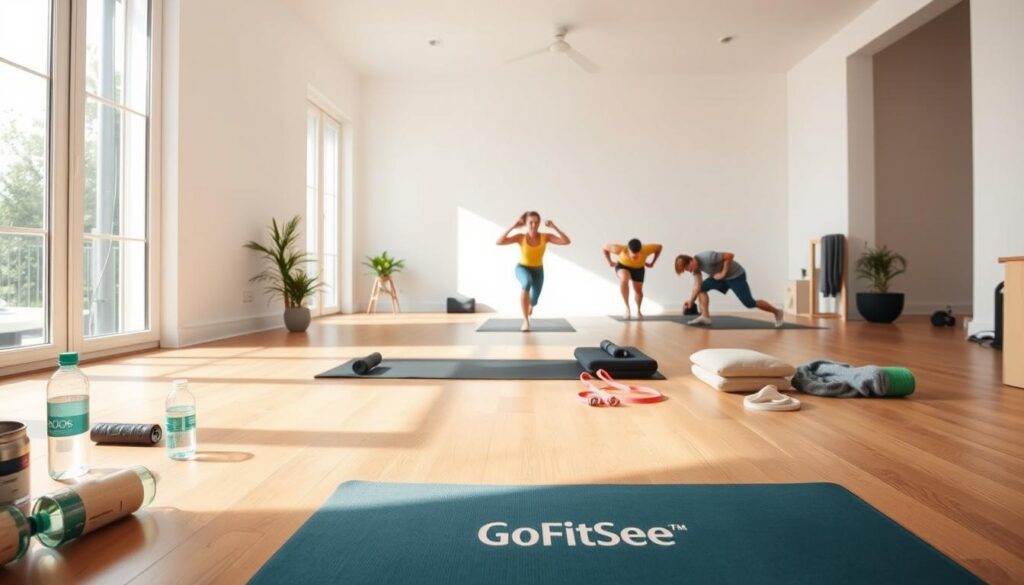Can you build muscle and stay fit without a gym or fancy gear? The answer might surprise you. Your living room can become your ultimate fitness zone with the right moves. No more excuses, just workouts that fit your schedule and space.
Home workouts without equipment are getting more popular. They’re simple, affordable, and adaptable. No gym contract? No problem. These routines use your body’s natural strength to boost endurance, burn calories, and sculpt muscles—all from anywhere. See how no equipment workouts can turn daily life into a fitness opportunity.
Table of Contents
Key Takeaways
- Bodyweight exercises build strength and flexibility without equipment.
- No equipment workouts save time and money compared to gyms.
- Short, consistent routines deliver visible results in weeks.
- Modify exercises to match any fitness level or space.
- Home workouts boost confidence through self-reliant progress.
Why Home Workouts Without Equipment Are Gaining Popularity
More people are choosing home workouts without equipment for fitness. These routines solve common problems like time, cost, and access. Let’s explore why they’re a favorite today.
Convenience and Accessibility Factors
No need to rush to the gym or wait for machines. At-home fitness routines can start in just five minutes, anytime. You don’t need any gear or space? Push-ups, squats, and planks are great alternatives.
Studies show 70% of adults like routines they can do anywhere. This makes these workouts perfect for busy lives.
Cost-Effectiveness Compared to Gym Memberships
Gym memberships cost about $682 a year. But, bodyweight workouts are free. Here’s the comparison:
- Average gym membership cost: $682/year
- Equipment needed: 0
- Savings: 100% with free home workouts without equipment
Flexibility in Schedule and Location
“Your living room is your gym.” – Fitness Trends Report 2023
Work out in the morning, at lunch, or after work. Travel? No issue. At-home fitness routines fit any space, from studios to hotel rooms. Say goodbye to missing workouts because of time or schedules.
Benefits of Bodyweight Training for Overall Fitness
Bodyweight training turns simple movements into effective workouts. You don’t need any equipment for exercises like push-ups or planks. These routines build strength that helps in everyday tasks, like carrying groceries or climbing stairs.
- Full-Body Engagement: Squats, lunges, and dips work many muscles at once. They improve coordination and balance.
- Cardio and Stamina: Circuit-style exercises like burpees or mountain climbers raise your heart rate. They boost endurance and burn calories.
- Injury Prevention: Strengthening your core with planks and bridges helps keep your back straight. This reduces back pain and strain.
Bodyweight exercises also sharpen your mental focus. Learning a pull-up or handstand push-up boosts confidence. Plus, you can adjust exercises to fit your level. For example, do push-ups on knees or add jump squats for more challenge.
Research from the Journal of Strength and Conditioning Research shows these routines increase metabolism and bone density. You don’t need heavy weights for this.
Bodyweight training is great for everyone, whether you’re starting out or already advanced. Try a 10-minute routine every day to see improvements in strength, stamina, and health. Your body has everything it needs to get started.
Essential Components of an Effective Home Workout Routine
To create a good home exercise programs or at-home fitness routines, you need more than just random moves. A solid routine has three main parts: warm-ups, balanced exercises, and cool-downs. Follow these steps to get the best results safely.
Warm-Up Techniques for Injury Prevention
Muscles need to get ready before working out. Start with 5–10 minutes of dynamic stretches like leg swings or arm circles. Then, do bodyweight squats or walking lunges to increase blood flow. Home exercise programs without warm-ups can lead to injuries. Choose movements that match your workout.
Balancing Cardio and Strength Exercises
Divide your workout time between cardio and strength exercises. For overall fitness, aim for a 50/50 split. Here are some examples:
- Jumping jacks + push-ups
- Mountain climbers + glute bridges
Change the ratio based on your goals. More cardio for weight loss, more strength exercises for muscle gain.
Cool-Down and Stretching Importance
After working out, slow down with light walking. Then, do static stretches for 20–30 seconds each. Focus on big muscle groups like hamstrings and shoulders. A fitness coach said:
“A proper cool-down isn’t optional—it’s how you stay consistent long-term.”
Stretching makes you more flexible and less stiff.
Getting Started: Creating Your Workout Space at Home
You don’t need a big room to exercise at home. Even small areas can be great for home exercise programs. Find a clear, flat spot without clutter. A corner of your living room, balcony, or bedroom can be perfect.
- Clear floor space for movements like jumping jacks or lunges.
- Use yoga mats or towels to prevent slipping.
- Check ceiling height if doing overhead exercises.
Good lighting and air make workouts better. Add a playlist or motivational quotes nearby. This helps you stay focused. Make your space a sign that it’s time to exercise.
Use everyday items in creative ways. A sturdy chair can be a step for elevated push-ups. A towel under your feet works for glute bridges. These tricks turn simple objects into tools for exercise without gym equipment. You can even tape lines on floors for balance drills or mark distances for agility exercises.
Don’t worry about making it perfect—just be consistent. Having a dedicated area, even temporarily, helps build the habit. Keep water nearby and lay out your workout clothes the night before. Small steps lead to big changes. Your space is ready when you are.
Full-Body Home Workouts Without Equipment for Beginners
You don’t need fancy gear or a gym to start working out. Home workouts without equipment are great for beginners. They help build strength and confidence. We’ll look at routines that fit into your busy schedule and match your pace.
Start each day with a 15-minute morning routine to boost energy and focus. Here’s a simple sequence:
- Squats: 20 reps to warm up legs
- Push-ups: 10-15 reps (knees bent if needed)
- Plank: Hold for 20-30 seconds
- Jumping jacks: 30 seconds for cardio
For longer workouts, try circuit training. Do exercises one after another with short breaks. Here’s an example:
- Mountain climbers (30 seconds)
- Bodyweight lunges (15 each leg)
- High knees (1 minute)
Do this 2-3 times, resting 30-60 seconds between each round.
Adjust the exercises to fit your level. Use:
- Wall push-ups for easier strength work
- Chair-assisted squats for knee support
- Shorter plank holds
to make no equipment workouts for everyone.
“Progress, not perfection, is the goal.”
Focus on doing the exercises right—slow and steady is best. Celebrate every small step towards being stronger and healthier!
Advanced Calisthenics Movements to Challenge Yourself
Ready to level up your calisthenics at home game? Try handstands, pistol squats, and muscle-ups. These exercises need strength, balance, and precision. They turn your body into a powerhouse without any equipment.
“Progress isn’t about speed—it’s about steady steps forward.” – Fitness Coach Sarah Lee

Begin with basic moves before tackling advanced ones. For example, work on shoulder stability with wall-assisted handstands. Then, move to freestanding handstands.
Pistol squats need strong quads and glutes. Start with box squats. One-arm push-ups require lots of practice. Begin with diamond push-ups and offset hand drills.
- Human flags: Train side planks and leg raises to build lateral core strength.
- Dragon flags: Master hanging knee raises before lifting legs fully.
- Muscle-ups: Combine pull-up and dip strength with dynamic transitions.
Keep track of your progress each week. Use resistance bands for help if you need. Always focus on form, not just how many reps you do. Celebrate every small victory; mastering these takes time.
Building Muscle Through Home Workout Plans
Building muscle at home is possible without weights. Bodyweight training and smart strategies can help. You can gain muscle using just your own strength. Here’s how to create effective home workout plans that focus on progressive overload and muscle specificity.
Progressive Overload Techniques Without Weights
- Increase reps: Aim for 1-2 extra reps each session
- Shorten rest: Reduce breaks between sets by 10-15 seconds weekly
- Add holds: Pause at hardest points during push-ups or dips
- Slow down: Take 4-5 seconds lowering during exercises
Targeting Specific Muscle Groups
| Muscle Group | Bodyweight Exercises | Progression Tips |
|---|---|---|
| Chest | Push-Ups, Ring Dips | Move hands closer together for triceps focus |
| Back | Inverted Rows, Supermans | Hold top position for 3 seconds |
| Legs | Squat Jumps, Bulgarian Split Squats | Raise heels on books to increase difficulty |
| Core | Hollow Holds, Plank Rotations | Extend hold time by 10 seconds weekly |
Sample Muscle-Building Routines
Try this 3-day split using bodyweight training:
- Day 1 (Upper Body): 4 sets each of push-ups, inverted rows, diamond push-ups
- Day 2 (Lower Body/Core): 3 sets of squat jumps, single-leg deadlifts, side planks
- Day 3 (Full-Body Circuit): 3 rounds of 20-second burpees + 15 tricep dips + 10 supermans
Adjust sets/reps weekly to keep challenging your muscles. Consistency with these home workout plans builds strength without equipment.
Cardio-Focused At-Home Fitness Routines to Burn Fat
Boost your calorie burn and fat loss with cardio that needs no equipment workouts. High-Intensity Interval Training (HIIT) is a science-backed method to maximize metabolic benefits in minimal time. These routines spike your heart rate, boost metabolism, and keep burning calories even after you finish.
Try these structured protocols to stay efficient and effective:
- Tabata: 20 seconds of work (e.g., burpees, jump squats) followed by 10 seconds rest, repeated for 4 minutes. Repeat cycles for 15–20 minutes.
- EMOM (Every Minute On the Minute): Perform 30 seconds of mountain climbers at the start of each minute. Use remaining time to rest or do low-impact moves like step touches.
- Descending Ladder: Do 10 jumping jacks, 8 high knees, 6 skaters, 4 butt kicks—then repeat backward. Add a 30-second plank between rounds.
For steady-state cardio, try shadowboxing, dance breaks, or brisk walking in place. Pair these at-home fitness routines with strength moves like push-ups or lunges to preserve muscle while shedding fat. Adjust intensity by modifying jumps to steps or slowing down intervals.
“HIIT’s time efficiency makes it ideal for busy lifestyles,” says a 2023 study in the Journal of Sports Science. “Even 15-minute sessions can yield significant fat loss results.”
Keep sessions dynamic and mix routines weekly to challenge your body. Consistency is key—just 3 days a week of these workouts can transform your metabolism and energy levels.
Overcoming Common Challenges in Home Exercise Programs

Staying on track with home exercise programs can be hard. But, we can overcome common obstacles and turn them into opportunities for growth.
Keep Motivation Alive
- Set daily reminders or calendar alerts to stick to your routine.
- Pair workouts with friends via video calls to add accountability.
- Track progress with apps like MyFitnessPal or Strava to see your growth.
Break Through Plateaus
When progress stalls, it’s time to shake things up:
- Change exercise order or add 10-second holds to pushups or squats.
- Try pyramid sets (e.g., 5 reps, rest, then 10 reps) to challenge muscles differently.
- Increase workout frequency gradually—add a 10-minute core session midday.
Work with Limited Space
“Even tiny spaces can host powerful workouts,” says NASM-certified trainer Sarah Lee.
Here are some space-saving exercises:
- Wall sits and calf raises (no floor space needed).
- Tricep dips using a sturdy chair.
- High knees or jumping jacks in a 3×3 foot area.
With a little creativity, exercise without gym equipment is always possible. Small tweaks can lead to big improvements. Stay adaptable, curious, and keep moving.
Measuring Progress and Setting Goals for Your No-Equipment Workouts
Tracking progress in home workouts without equipment turns effort into results. Start by choosing clear metrics to watch. For example, count how many push-ups or planks you can do each week. Track time—like how long you hold a yoga pose or complete a circuit. Note rest breaks between sets too.
Set goals using the SMART method: Specific, Measurable, Achievable, Relevant, and Time-bound. Want to improve push-up reps? Aim for “20 push-ups in 30 seconds by next month.” Use a journal or app to log weekly updates. Celebrate small wins like adding one more rep or reducing rest time between sets.
“Progress in bodyweight training isn’t just about numbers. It’s also about feeling stronger, moving better, and staying consistent,” says fitness coach Sarah Miller.
Take photos monthly to see posture and muscle changes. Heart rate during workouts can show improved endurance. And don’t forget non-physical wins: better sleep, less stress, or more energy. These matter too!
Adjust goals as you grow stronger. If you master 20 push-ups, aim for 30 next month. Bodyweight training progress is gradual—focus on steady steps forward. Celebrate every milestone, big or small, to stay motivated.
Combining Nutrition with Your Bodyweight Training for Optimal Results
Nutrition is crucial for getting the most out of home workout plans or calisthenics at home. The right food fuels your workouts and helps you recover faster. Start by balancing proteins, carbs, and fats to meet your goals.
- Protein rebuilds muscles: Aim for 0.7-1 gram per pound of body weight daily.
- Carbs power your workouts: Focus on whole grains, fruits, and veggies.
- Healthy fats support energy: Nuts, avocados, and olive oil are smart picks.
| Macronutrient | Role | Examples |
|---|---|---|
| Protein | Muscle repair | Chicken, tofu, Greek yogurt |
| Carbohydrates | Energy for workouts | Oats, sweet potatoes, quinoa |
| Fats | Hormonal health | Almonds, salmon, chia seeds |
Eat a snack rich in protein and carbs within 30 minutes after working out. Drink water before, during, and after your sessions. Stay away from sugary drinks, as they can cause energy crashes.
For calisthenics at home, timing is everything. Match your meals with your workout times to avoid feeling tired. Simple changes, like swapping chips for nuts or soda for infused water, can make a big difference. It’s not about being perfect; it’s about being consistent. Combine smart eating with your home workout plans for faster results.
Conclusion: Transforming Your Fitness Journey with Simple Home Workouts
At-home fitness routines show that you can reach your fitness goals without fancy equipment. You don’t need a lot of time, money, or space. Your body is all you need to get stronger and more fit.
These exercises are flexible and fit into any busy schedule. You can do push-ups, planks, and more without leaving your house. They help build muscle, increase your metabolism, and keep your heart healthy.
Consistency is key, not perfection. Start with easy exercises and add harder ones later. Keep track of your progress and change your workouts to keep things interesting. If you lose motivation, go back to the tips for staying on track.
Even the smallest spaces can be used for workouts. Get creative with exercises in corners or doorways.
Start with a 15-minute workout today. Over time, these simple steps will become a part of your daily routine. Your home is your gym. Just put on your shoes, clear a small area, and begin your journey to a stronger, healthier you. All you need is your body and determination.
FAQ
What are some effective home workouts without equipment?
How can I create a home workout plan that suits me?
Are bodyweight exercises as effective as gym workouts?
Can I really build muscle with home workouts?
How do I stay motivated to exercise at home?
What are the best exercises for beginners?
How do I effectively warm up before a home workout?
Can I get a good cardio workout at home without equipment?
Read More
Brown Sugar Alternative: Delicious Swaps for Your Sweet Recipes
Reduce Sugar Cravings | How to Curb Sugar Cravings: 7 Effective Strategies You Haven’t Tried
Understanding White Marks on Lips: Causes, Treatments, and Prevention
Plant-Based Diet Benefits: Transform Your Health in 30 Days
Glowing Skin Secrets 2025: Discover the Benefits of Drinking Green Tea for Skin








